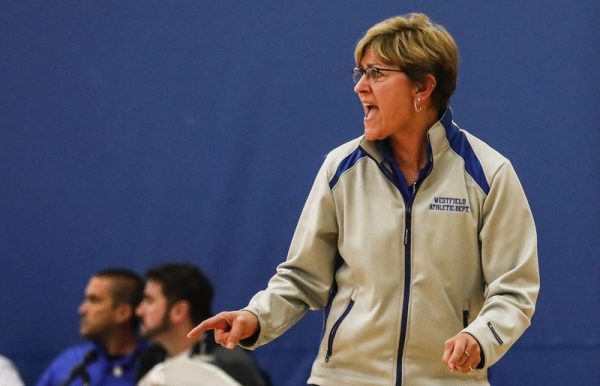“We usually don’t get a lot of fans”
It’s a Monday afternoon and the WHS girls basketball team, led by senior Molly Ryan, has just beaten one of its biggest rivals, Cranford. Yet, even though this is one of the most important games of the season, the stands are virtually empty, the majority of the fans being family of the players.
Ryan, who is going on to play basketball at Tufts University next year, has mixed emotions about the lack of fans. “In games like these and county games, it would be great to have more fans like the boys had against Roselle Catholic,” she says after the game. “But at the same time, I didn’t even notice it because I’m so used to it at this point.”Welcome to the world of female sports in 2018: While women now have the same opportunities to participate in sports as men do, they also continue to fight for equal recognition and appreciation.In 1972, legislation known as Title IX was passed, allowing women and girls to have equal opportunity in education, athletics included. According to the Women’s Sports Foundation, only 1 in 27 girls played high school sports before Title IX was passed. Now, 2 in 5 girls play high school sports. Today, female athletes are seen on national TV in the Olympics, and on the covers of some of the world’s most popular magazines.
At WHS, sports have always been popular. But 50 years ago, WHS only fielded seven girls teams, two of which were intramural and one of which was twirling. Currently, we have 14 girls varsity teams at WHS. Yet in our school, girls sports are often overlooked. There are equal numbers of teams for each gender, but the attendance at these sports games does not reflect this seemingly equal opportunity. WHS students crowd the stands for the boys soccer team’s home matchup against rival Scotch Plains-Fanwood High School, but the stands are mostly barren for the girls’ matchup against the same school.
Senior soccer and basketball athlete Grace Elliott believes that attendance at girls games is a big issue within the school. “The atmosphere at most boys games is crazy,” she said. “There is always a lot of school spirit and the energy is just contagious. There isn’t as much support for girls games. We usually don’t get a lot of fans.”
Could lack of publicity be the problem? Freshman Juliana Schuttevaer believes it is. “The boys games are more popular because they’re publicized more. Most people don’t even know about the girls teams.”
Michael Leniart, owner of the social media account “Dubfield Athletics,” thinks that the lack of attendance for girls games is not due to inadequate publicity. “We advertise boys and girls games on Dubfield, but obviously sports like football, boys soccer and hockey are going to get bigger crowds just because that’s what most people are into,” Leniart said.
Students often exacerbate this attendance issue by choosing to attend boys games over girls games. “If the girls are playing at the same time that the boys are playing, people are going to go to the boys game,” said teacher and soccer coach Ms. Katherine Wertheimer. “I would like to see that attitude change.”
Wertheimer noted that the girls soccer team was undefeated entering its state title game. “I know that our football team went undefeated as well and I would venture to say that there’s a lot more people who know about that,” she said.
The issue has nothing to do with a lack of excitement in girls sports. “I think that girls games are just as exciting and just as competitive,” said Athletic Director Ms. Sandy Mamary. “Girls and women have become incredible athletes, so I don’t get it.”
Despite this obstacle, girls sports have certainly grown immensely in a short amount of time. “There are more intermediate-school options than there were, and new sports like girls ice hockey,” said Ms. Caitlin Macdonald, WHS teacher and softball and field hockey coach. “So we’ve added more opportunities for girls to compete.”
WHS parent Ms. Ruth Maloney remembers her childhood participation in athletics as being very different from today. “I never played organized sports until high school,” Maloney said. “Compared to today’s barrage of choices at incredibly young ages, my experience was significantly narrower because I was female.”
The unequal support for female sports is not only prevalent in Westfield, but also in surrounding towns. Scotch Plains-Fanwood High School has many of the same problems as WHS, according to Ryan Miller, the school’s vice principal of athletics. “Recognition and fan support continue to be the largest hurdle to overcome at SPFHS,” Miller wrote in an email. “Our female programs are some of the best in the county and we do not garner the support that is equivalent.”
Gender inequality is much bigger than just high school sports. We see it in the world of college and professional athletics as well; it’s become a reality. One example is the gender pay gap between the U.S. men’s national soccer team and the U.S. women’s national team, which exists despite the fact that the women have won three World Cups as opposed to none for the men. Another is the attendance differential between NBA and WNBA games: Last season, the men’s pro league averaged nearly 18,000 fans per game, while the women’s league averaged just below 8,000 per matchup.
But it’s not just a question of who gets paid more and who has larger attendance figures. There are also extreme distinctions between how female athletes are covered in th e media versus male athletes. Every February, we see women posing in bikinis on the cover of Sports Illustrated, whereas their male counterparts are depicted in ways that promote their strength. Oftentimes, the media focuses on physical attractiveness in female athletes, instead of on their athletic prowess. “This takes away from their abilities as athletes,” Elliott said. “It doesn’t give them the respect and attention that these professionals deserve.”
In the end, gender inequality in sports will continue to be a relevant issue in society until we can find a definitive solution to the problem. “As long as perceptions exist that girls sports are somehow not as exciting to watch, and girls and women in general are not supported with real intentions for equality, the situation will remain the same,” Maloney said. “As long as we remain a society that values money more than people, the bottom line will continue to motivate decisions.”
At WHS, sports have always been popular. But 50 years ago, WHS only fielded seven girls teams, two of which were intramural and one of which was twirling. Currently, we have 14 girls varsity teams at WHS. Yet in our school, girls sports are often overlooked. There are equal numbers of teams for each gender, but the attendance at these sports games does not reflect this seemingly equal opportunity. WHS students crowd the stands for the boys soccer team’s home matchup against rival Scotch Plains-Fanwood High School, but the stands are mostly barren for the girls’ matchup against the same school.
Senior soccer and basketball athlete Grace Elliott believes that attendance at girls games is a big issue within the school. “The atmosphere at most boys games is crazy,” she said. “There is always a lot of school spirit and the energy is just contagious. There isn’t as much support for girls games. We usually don’t get a lot of fans.”
Could lack of publicity be the problem? Freshman Juliana Schuttevaer believes it is. “The boys games are more popular because they’re publicized more. Most people don’t even know about the girls teams.”
Michael Leniart, owner of the social media account “Dubfield Athletics,” thinks that the lack of attendance for girls games is not due to inadequate publicity. “We advertise boys and girls games on Dubfield, but obviously sports like football, boys soccer and hockey are going to get bigger crowds just because that’s what most people are into,” Leniart said.
Students often exacerbate this attendance issue by choosing to attend boys games over girls games. “If the girls are playing at the same time that the boys are playing, people are going to go to the boys game,” said teacher and soccer coach Ms. Katherine Wertheimer. “I would like to see that attitude change.”
Wertheimer noted that the girls soccer team was undefeated entering its state title game. “I know that our football team went undefeated as well and I would venture to say that there’s a lot more people who know about that,” she said.
The issue has nothing to do with a lack of excitement in girls sports. “I think that girls games are just as exciting and just as competitive,” said Athletic Director Ms. Sandy Mamary. “Girls and women have become incredible athletes, so I don’t get it.”
Despite this obstacle, girls sports have certainly grown immensely in a short amount of time. “There are more intermediate-school options than there were, and new sports like girls ice hockey,” said Ms. Caitlin Macdonald, WHS teacher and softball and field hockey coach. “So we’ve added more opportunities for girls to compete.”
WHS parent Ms. Ruth Maloney remembers her childhood participation in athletics as being very different from today. “I never played organized sports until high school,” Maloney said. “Compared to today’s barrage of choices at incredibly young ages, my experience was significantly narrower because I was female.”
The unequal support for female sports is not only prevalent in Westfield, but also in surrounding towns. Scotch Plains-Fanwood High School has many of the same problems as WHS, according to Ryan Miller, the school’s vice principal of athletics. “Recognition and fan support continue to be the largest hurdle to overcome at SPFHS,” Miller wrote in an email. “Our female programs are some of the best in the county and we do not garner the support that is equivalent.”
Gender inequality is much bigger than just high school sports. We see it in the world of college and professional athletics as well; it’s become a reality. One example is the gender pay gap between the U.S. men’s national soccer team and the U.S. women’s national team, which exists despite the fact that the women have won three World Cups as opposed to none for the men. Another is the attendance differential between NBA and WNBA games: Last season, the men’s pro league averaged nearly 18,000 fans per game, while the women’s league averaged just below 8,000 per matchup.
But it’s not just a question of who gets paid more and who has larger attendance figures. There are also extreme distinctions between how female athletes are covered in th e media versus male athletes. Every February, we see women posing in bikinis on the cover of Sports Illustrated, whereas their male counterparts are depicted in ways that promote their strength. Oftentimes, the media focuses on physical attractiveness in female athletes, instead of on their athletic prowess. “This takes away from their abilities as athletes,” Elliott said. “It doesn’t give them the respect and attention that these professionals deserve.”
In the end, gender inequality in sports will continue to be a relevant issue in society until we can find a definitive solution to the problem. “As long as perceptions exist that girls sports are somehow not as exciting to watch, and girls and women in general are not supported with real intentions for equality, the situation will remain the same,” Maloney said. “As long as we remain a society that values money more than people, the bottom line will continue to motivate decisions.”





